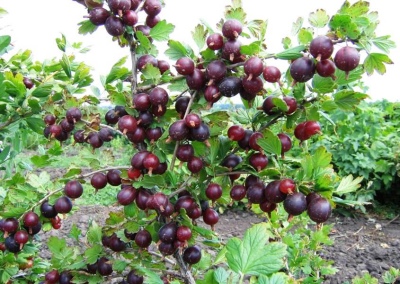
- Name synonyms: Spinefree
- Growth type: medium-sized
- Description of the bush: sprawling, spherical crown, wide
- Escapes: arcuate curved
- Sheet: large, green
- Berry size: medium and large
- Berry weight, g: 4,5
- Berry color: dark red, with green veins all over
- Taste: sweet, dessert
- Appointment: fresh use, for juice and wine, for making preserves, jams, marmalades
Spinefree is a gooseberry variety very well known to horticultural professionals. The plant has many advantages over other similar species. But in order to get a decent harvest from it, it is necessary to carry out competent care.
Breeding history
Spinefree gooseberry (synonym and original name - Spinefree) has been known for a long time. The variety was obtained in Canada by breeders in the distant 1935. Scientists took the weak-thorn gooseberry as a basis and crossed it with the English Victoria. In the next generation of selection, when a thornless form of culture appeared, work was carried out to cross it with the Canadian Melby gooseberry variety. The result was a completely studless Spinefree.
Description of the variety
The thornless variety of shrub of the considered variety has a spreading, rounded crown. The maximum plant height is 120 centimeters. The shoots are arched, they are large. The foliage is colored bright green.
The Canadian gooseberry has many benefits:
- delicious fruits;
- lack of thorns;
- good frost resistance (tolerates temperatures up to -35 degrees);
- stable fruiting;
- increased resistance to many diseases and attacks of insect pests;
- good transportability.
There are also disadvantages:
- picky about lighting;
- annual pruning is needed.
Characteristics of berries
Spinefree gooseberries turn from green at the ripening stage into spectacular dark red berries at full ripeness. The bush looks very decorative. In shape, these are round, slightly oblong berries, and in size they are medium and large, weighing from 4 to 6 grams.
Taste qualities
Spinefree gooseberry is dessert-like in taste and has a pronounced sweetness. Most often it is consumed fresh, but it can also be used for making juice or wine, as well as cooking preserves, marmalades, jam.
Ripening and fruiting
The gooseberry variety from Canada ripens in our country in July. Therefore, it can be attributed to crops with an average ripening period.
Yield
Differs in a rather high yield, namely: up to 4-6 kg of berries from each bush.
Landing
The culture is undemanding in relation to the soil. It can grow well both on clay, loamy, sandy loam and sandy soil. An exception is sour, swampy, cold soil.
Shrubs can be planted both in autumn and spring. This is the end of September or the end of March, respectively. As for the middle zone of the Russian Federation, it is better to plant here in the fall. In this case, the bushes take root well.
Landing is carried out according to the standard scenario. Dig holes 60 cm deep and half a meter wide. Between two bushes, it is necessary to maintain from a meter to one and a half, and in the aisles this figure will be more - 1.5-2 m.
The necessary feeding should be laid in all pits:
- 50 g of lime;
- 300 g of ash;
- 150 g superphosphate;
- 10 kg of manure.
When planting a seedling, the tops of the branches should be cut off, leaving 5 buds each. Next, it remains to install the bush in the hole, cover it with earth and tamp it. Then you can water and cover with mulch.

Growing and care
Agrotechnical measures include watering, loosening, mulching, pruning, preventive treatment against insect pests and infections, feeding. In the absence of care, the Canadian Spinefree shrub will grow and bear fruit poorly, it may even die.
Shrub irrigation is carried out as the soil dries out. Usually this is a one-time watering once a week and a half. At the stage of berry ripening, the culture will especially need moisture, so watering is increased.
Do not fertilize gooseberries during the first three years after planting, after which they set up a schedule of annual feeding according to the usual scheme.



Disease and pest resistance
Spinefree gooseberry is resistant to attacks of harmful insects, fungal diseases, as well as American powdery mildew.

In order for the gooseberry to produce a good harvest, it is necessary to devote time to disease prevention.
Resistance to adverse climatic conditions
Winter hardiness and drought resistance are high.




































































